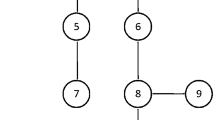Abstract
We consider a mathematical model of market competition between two parties. The parties sequentially bring their products to the market while aiming to maximize profit. The model is based on the Stackelberg game and formulated as a bilevel integer mathematical program. The problem can be reduced to the competitive facility location problem (CompFLP) with a prescribed choice of suppliers which belongs to a family of bilevel models generalizing the classical facility location problem. For the CompFLP with a prescribed choice of suppliers, we suggest an algorithm of finding a pessimistic optimal solution. The algorithm is an iterative procedure that successively strengthens an estimating problem with additional constraints. The estimating problem provides an upper bound for the objective function of the CompFLP and is resulted from the bilevel model by excluding the lower-level objective function. To strengthen the estimating problem, we suggest a new family of constraints. Numerical experiments with randomly generated instances of the CompFLP with prescribed choice of suppliers demonstrate the effectiveness of the algorithm.
Similar content being viewed by others
References
V. L. Beresnev and V. I. Suslov, “A Mathematical Model of Market Competition,” Sibir. Zh.Industr.Mat. 12 (1), 11–24 (2009) [J. Appl. Indust. Math. 4 (2), 147–157 (2010)].
H. von Stackelberg, The Theory of the Market Economy (Oxford Univ. Press, Oxford, 1952).
V. L. Beresnev and A. A. Melnikov, “The Branch-and-Bound Algorithm for a Competitive Facility Location Problem with the Prescribed Choice of Suppliers,” Diskretn. Anal. Issled. Oper. 21 (2), 3–23 (2014) [J. Appl. Indust. Math. 8 (2), 177–189 (2014)].
A. A. Melnikov, “Randomized Local Search for the Discrete Competitive Facility Location Problem,” Avtomat. Telemekh. No. 4, 134–152 (2014) [Automat. Remote Control 75 (4), 700–714 (2014)].
V. L. Beresnev, “On the Competitive Facility Location Problem with a Free Choice of Suppliers,” Avtomat. Telemekh. No. 4, 94–105 (2014) [Automat. Remote Control 75 (4), 668–676 (2014)].
V. L. Beresnev, “Branch-and-Bound Algorithm for a Competitive Facility Location Problem,” Comput. Oper. Res. 40 (8), 2062–2070 (2013).
V. L. Beresnev and A. A. Melnikov, “Exact Method for the Capacitated Competitive Facility Location Problem,” Comput. Oper. Res. 95, 73–82 (2018).
L. Cánovas, A. García, M. Labbé, and A. Marín, “A Strengthened Formulation for the Simple Plant Location Problem with Order,” Oper. Res. Lett. 35 (2), 141–150 (2007).
P. Hanjoul and D. Peeters, “A Facility Location Problem with Clients’ Preference Orderings,” Reg. Sci. Urban Econ. 17 (3), 451–473 (1987).
I. Vasil’ev, X. Klimentova, and M. Boccia, “Polyhedral Study of Simple Plant Location Problem with Order,” Oper. Res. Lett. 41 (2), 153–158 (2013).
S. Dempe, Foundations of Bilevel Programming (Kluwer Acad. Publ., Dordrecht, 2002).
M. Hemmati and J. C. Smith, “A Mixed-Integer Bilevel Programming Approach for a Competitive Prioritized Set Covering Problem,” Discrete Optim. 20, 105–134 (2016).
V. L. Beresnev and A. A. Melnikov, “Cut Generation Algorithm for the Discrete Competitive Facility Location Problem,” Dokl. Akad. Nauk 80 (5), 515–518 (2018) [Dokl. Math. 97 (3), 254–257 (2018)].
V. L. Beresnev and A. A. Melnikov, “Approximation of the Competitive Facility Location Problem with MIPs”, Comput. Oper. Res. 104, 139–148 (2019).
J. T. Moore and J. F. Bard, “The Mixed Integer Linear Bilevel Programming Problem,” Oper. Res. 38 (5), 911–921 (1990).
Gurobi Optimizer Reference Manual, Gurobi Optimization (2018). Available at https://www.gurobi.com/documentation/8.1/refman.pdf (accessed Feb. 11, 2019).
Benchmark Library ‘Discrete Location Problems’, available at http://math.nsc.ru/AP/benchmarks/english.html (accessed Feb. 11, 2019).
Author information
Authors and Affiliations
Corresponding authors
Additional information
Russian Text © The Author(s), 2019, published in Diskretnyi Analiz i Issledovanie Operatsii, 2019, Vol. 26, No. 2, pp. 5–29.
Rights and permissions
About this article
Cite this article
Beresnev, V.L., Melnikov, A.A. A Cut Generation Algorithm of Finding an Optimal Solution in a Market Competition. J. Appl. Ind. Math. 13, 194–207 (2019). https://doi.org/10.1134/S1990478919020029
Received:
Revised:
Accepted:
Published:
Issue Date:
DOI: https://doi.org/10.1134/S1990478919020029




